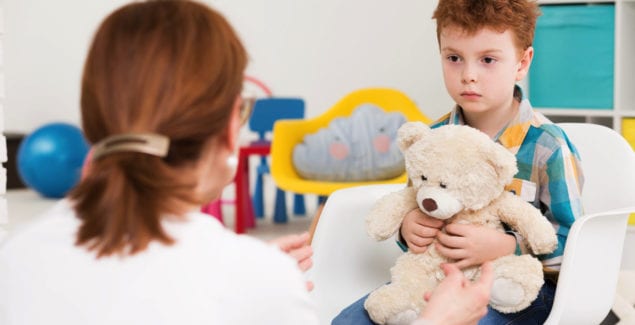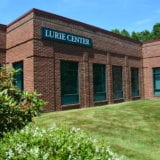Treatment of Autism Spectrum Disorder

Posted in: Parenting Concerns
Topics: Autism Spectrum
Christopher Keary, MD; Lisa Nowinski PhD; Christopher McDougle, MD
Sam is an adorable 5-year-old boy with curly brown hair and large inquisitive eyes. As a baby, Sam was easy! He rarely cried and seemed to entertain himself for hours – the perfect first child. But by his 1st birthday, Sam was not yet talking. Family and friends thought he might be shy. He tended to play on the outskirts of the playground and enjoyed being on his own. By the time he was 18 months old, he was using a few single words to express his wants and needs; however, his parents were concerned that he was not talking as much as other kids his age.
Despite this, Sam’s motor skills were strong. He sat up, started to crawl, and walked at the usual times, though he tended to walk on his toes and he sometimes became uncontrollably “excited.” He would spin his body in circles with his back arched, head tiled up, and hands flapping by his side. Sam could spend hours examining his collection of toy trains, but never seemed interested in the train track table or other toys such as action figures or dolls. He carried his favorite toy train everywhere and had a keen sense to find small, round items like buttons and coins wherever he went. Although his parents loved his passion for trains and attention to detail, they worried about his language delays and limited social play.
After consulting with their pediatrician, Sam was referred for a developmental evaluation and ultimately diagnosed with an autism spectrum disorder (ASD). Sam’s diagnosis was earth-shattering. With the diagnosis, his parents were hit with a wave of tremendous sadness mixed with a sense of relief that they had an answer. The diagnosis came with so many unknowns, questions, and worries about the future. Will my child speak? Will he ever make friends? Will he go to college? Will he get married? Will he be happy? Quickly, his parents became overwhelmed by the long “to do” list. They wanted to do everything to help Sam, but were lost in a sea of acronyms and unknown treatments.
***
So, what is ASD?
ASD is a life-long developmental disorder that is usually diagnosed in childhood. Children with ASD have trouble with social interactions and communication. They can also become focused or stuck on specific topics. They might have a tendency to move their hands or rock repetitively or have other unusual behaviors. Although these behaviors may appear strange, they are often enjoyable for the person with ASD.
Despite the challenges, many people with ASD have strengths or skills in specific areas such as art, music, or math. Although their social interactions may seem unusual, many people with ASD enjoy interacting with others and making friends. They are often creative, thoughtful, and can have a great sense of humor.
So, what can we do?
Fortunately, there are many things we can do to help children with ASD learn and flourish. All children with ASD benefit from intervention and support to reduce their challenging symptoms and increase their abilities and independence. Children who are diagnosed early are able to begin treatment right away.
Still, entering into the world of autism treatment can be overwhelming. There are many different treatments and acronyms for parents to learn. Here are some of the common treatments for ASD.
Early Behavioral Therapies
Early and intensive intervention for ASD has been found effective at building skills and reducing symptom severity over time. Early intervention is associated with the best long-term outcomes.
- Applied Behavior Analysis (ABA) is one of the most common and well-researched interventions for ASD. During ABA, a therapist will break down complex behaviors into smaller, ‘discrete’ skills and teach those skills in a systematic fashion over time using repetition and reinforcement.
- Pivotal Response Training® (PRT) is similar to ABA, but focuses on ‘pivotal’ areas of learning and development, such as motivation, self-management, and social initiation. PRT uses natural reinforcers to build new skills and behaviors, rather than the tangible and edible reinforcers in traditional ABA.
- Floortime is an early intervention that focuses on a child’s broad social-emotional development, rather than isolated or discrete skills. Intervention is primarily play-based and focuses on activities that are appropriate to a child’s developmental level and interests.
- Early Start Denver Model (ESDM) combines elements of structured ABA with more informal ‘relationship-based’ approaches to intervention. ESDM pulls from the therapeutic methods described above.
Speech, Occupational, & Other Therapies
Although many of the primary interventions for ASD involve behavioral treatment, other therapies can be instrumental in treating the language, motor, and sensory challenges children with ASD experience.
- Speech Therapy is an important intervention aimed to build basic language skills, improve articulation, and strengthen social communication skills. Because some children with ASD do not communicate with spoken words, speech therapy can also be helpful in teaching children to use technology to help them communicate. These Augmentative/Alternative Communication (AAC) strategies might include the use of pictures (Picture Exchange Communication System or PECS) or high-tech devices such as specially designed apps for an iPad or tablet.
- Occupational Therapy can help to address delays in gross motor coordination and fine motor skills. Improving these skills help children with ASD develop increased independence with functional life skills and may even improve early cognitive development.
- Sensory Integration Therapy can help to address the sensory processing challenges that many children with ASD experience. Although the empirical support for sensory integration therapy is limited, many families find sensory integration approaches helpful.
Psycho-Social Therapies
Many children and teens with ASD yearn for relationships but may experience social isolation, exclusion, or outright bullying. These challenges can become especially difficult during middle school when cliques and popularity loom large. Parents may also struggle to find the right way to support their child’s social interactions and behavior.
- Social Skills Intervention is an integral part of treatment for ASD and builds social competence in a welcoming and fun environment. These groups often use a combination of formal and informal teaching to help children learn to navigate social interactions. Building on a child’s hobbies and interests can be a great way to encourage social interaction in smaller groups. Whether it is music, history, robotics, or anime, such groups can be a great way to find a welcoming community that shares an interest.
- Parent Management Training and Family Therapy can help to reduce parent stress and improve management of problematic behaviors such as aggression, non-compliance, and self-injury in children with ASD. Family therapy, including couples counseling, may be helpful in supporting the overall well-being of a family system.
- Cognitive Behavioral Therapy (CBT) may be helpful in reducing psychiatric symptoms such as anxiety in individuals with ASD.
Managing Medical & Behavioral Health Concerns
Most people with ASD live long and healthy lives. However, some children with ASD may experience medical difficulties like seizures, sleep difficulties, and stomach problems. Children with ASD are at higher risk for certain medical conditions, such as constipation, gastroesophageal reflux disease (GERD), or seizure disorders. It is not uncommon for children and teens with ASD to see specialists such as gastroenterologists or neurologists in addition to their pediatrician. In children who have limited ability to express pain or other physical symptoms, even seasonal allergies can be difficult to identify.
Behavioral health problems are also not uncommon. Some children with ASD experience problems with hyperactivity, severely persistent repetitive behaviors, or aggressive/self-injurious episodes. Behavioral therapies such as ABA, described above, can help reduce these behaviors. In severe situations behavioral medications can also be helpful and can be prescribed by psychiatrists, behavioral neurologists, developmental pediatricians or psychiatric nurse practitioners. Reducing these behaviors can allow schooling to be more effective and allow for increased independence and community involvement.
Children who are “higher functioning” on the spectrum can be particularly at risk for anxiety disorders and depression, especially if they feel estranged and ostracized from peers. Sensory sensitivities can make routine experiences such as thunderstorms or crowded rooms difficult and changes in the usual routine can be highly anxiety provoking. Among people who have insight into their diagnosis, the teenage/young adult years can be difficult as they struggle to find their niche and worry about how they will handle the demands of adulthood. Seeing a therapist can be helpful in developing skills to identify and manage emotions and to cope with the frustration and confusion that may come with social interactions and demands.
Family Support
All of these different care needs can feel overwhelming. But there is a larger community of people and families who care for and love someone with ASD, and connecting to this community can make all the difference. The Autism Treatment Network (ATN) is a group of autism centers across North America that helps to connect families to information, services, and supports.
Contacting the ATN Autism Response Team can help in finding local providers and parent/caregiver support. They can also help in learning about federal laws that protect educational rights for children with ASD. Many states have specific laws that protect and ensure insurance coverage for ASD-related care.
Autism Spectrum Disorder is a lifelong condition and there is no crystal ball to know what the future will hold. That being said, all children can learn new skills towards making progress in pursing the greatest possible independence and quality of life.
To get in touch with a member of the Autism Response Team:
- Call 888-288-4762 or en Español 888-772-9050
- Email familyservices@autismspeaks.org
In addition, The Autism Speaks First 100 Days Kit provides a wonderful guide for families navigating a new ASD diagnosis.

 Share
Share Tweet
Tweet





